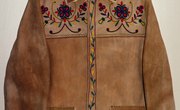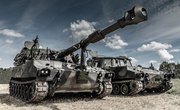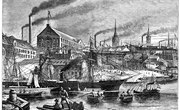The history of logging equipment dates to the pick and ax, but mechanized logging equipment did not emerge until the late 19th century with the invention of the steam donkey winch, band saws and, later, trucks powered by gasoline-powered engines. Operating early equipment was dirty, dangerous work. Modern equipment today has eliminated most danger associated with heavy timber cutting and transportation.
19th Century
Logging equipment originated, using the simple brute strength of humans and animals. Large gang saws, usually requiring two men to operate, felled trees. Bull teams using horses and donkeys to pull sleighs and wagons transported cut logs to rivers to be floated downstream to timber mills, according to VanNattaBros.com.
Greasing the Skids
To move cut logs down a trail, skids, or long poles, were laid crossways on the trail. The lead end of each log was tapered with an ax. Lard, or whatever greasing material was available, was applied to the skids to easily move the logs down the trail.
Steam Donkey
By 1882, the steam donkey, a steam-powered winch, became widely available and led to cable logging. Using cable, a hoist and equipped with huge drums or spools, the steam donkey could move logs from the forest to the trail for transportation to the mills downstream.
Saws
At the turn of the 20th century, the two most common saws to cut trees were the gang saw and the rotary saw. Timber mills employed large band saws on lumber that could handle large-diameter logs. Band saws generally measured four inches wide, 19 inches long and had a 22-gauge thickness.
Sleighs and Jammers
Logging sleighs in the 19th and early 20th century were horse-drawn and, later, truck-driven, wagons that transported timber from the forest to the river or railroad tracks. A water sleigh was a wagon equipped with a 3,000-gallon water tank. Water was released onto the ice during winter to make the trail smooth and slick for easy movement of timber. Sleighs transported the timber to A-frame jammers that loaded the lumber onto flatbed railroad cars, according to the Minnesota Historical Society.
Vehicles
The articulated tractor-trailer truck emerged in the 1920s, but it was not until the late 1930s that semi trucks specifically designed to haul timber over long distances on paved roads were perfected. T.A. Peterman was a logging tycoon who founded Peterbilt in Tacoma, Wash., and purchased the Fageol truck company, the Waukesha Motor Company and surplus army trucks. With this equipment and parts, he developed custom chain-driven logging trucks that remain the standard in logging trucking today.
Today’s Equipment
Today’s logging equipment is more technologically advanced, safer to operate and more efficient. Most equipment allows the operator to work in an enclosed cab. Reducing operator fatigue are track feller bunchers, which gather timber; skidders, which remove logs from the forest; and loaders that collect timber to place on transport vehicles, according to TigerCat.com.
Related Articles
Resources
Writer Bio
Rob Wagner is a journalist with over 35 years experience reporting and editing for newspapers and magazines. His experience ranges from legal affairs reporting to covering the Middle East. He served stints as a newspaper and magazine editor in Saudi Arabia and the United Arab Emirates. Wagner attended California State University, Los Angeles, and has a degree in journalism.











